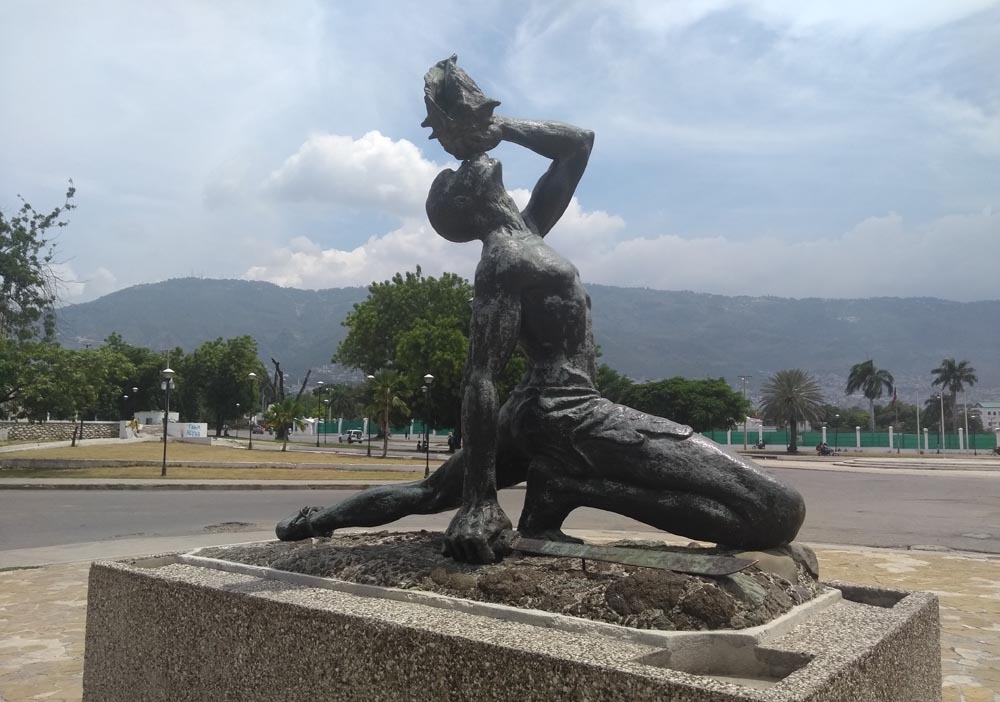Part 2
By Dean Karalekas
For lunch, we rode back to Jalousie, one of Haiti’s largest slums, whose people live lives of privation and dignity in the face of unimaginable hardship. This Port-au-Prince neighbourhood is easily recognizable even to people who have never been here: it is the pastel-painted favela—at least, when viewed from the vantage point of more well-to-do areas—that emblazons the cover of many a guidebook. These gaily painted concrete structures put a colourful mask over what are often grey conditions of poor sanitation, intermittent electricity, and abject poverty. This is where Azda lives, and walking the narrow streets and alleyways, he told me about growing up here and the problems they face. Education, it seems—or at least a good education—is a luxury reserved for people with money in Haiti, and indeed, we passed an outdoor schoolroom, complete with makeshift desks and blackboard, where some enterprising teacher was attempting to address this deficit.
We stopped at a small local restaurant for lunch—or in my case, breakfast: since I hadn’t time enough for food before leaving for the airport this morning. My God, was that this morning? It seems like days had gone by. Men sat at the bar enjoying a beer. A television was playing a cartoon show, and some local kids were enjoying the program. Lunch consisted of chicken, beans and fried plantain, and of course lots of water. I had been drinking enormous amounts of water to replenish what I had been losing in sweat. The sun was unrelenting, and I knew I’d pay for my exposure to it soon. It would have been nice to have had the opportunity, here seated, to hear more about life in Jalousie from Azda, but the patron at the table next to ours was playing his radio, blasting Compas music at ear-splitting volume. I tried not to react in anger, and gave him the benefit of the doubt – maybe he thought he was making the dining experience more enjoyable for us?
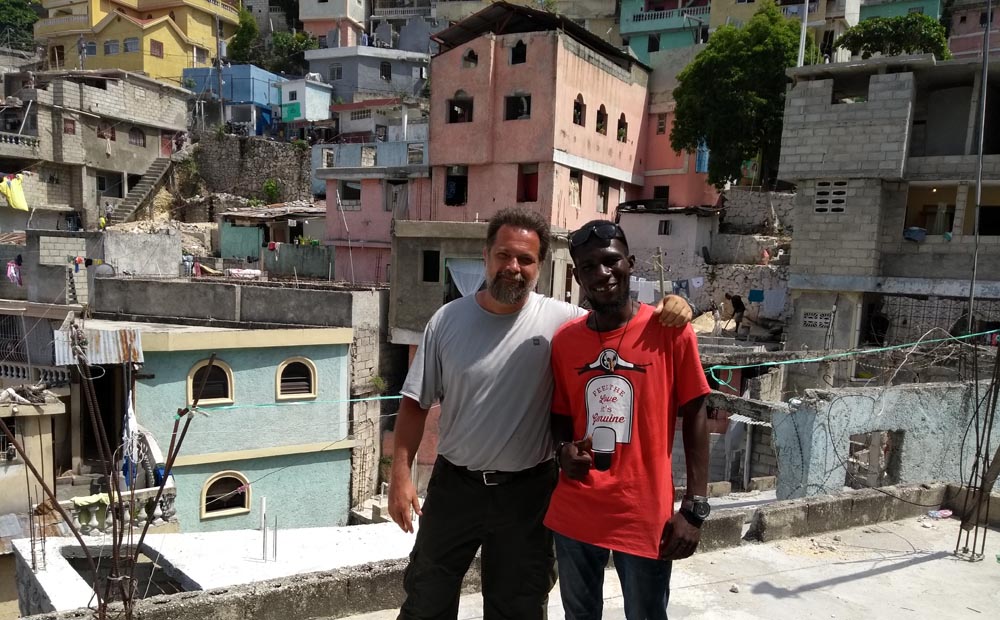
Azda and Vlad spent the rest of the afternoon showing me around some of the must-see attractions in Port-au-Prince: the distinctive statue of Le Marron Inconnu, forever frozen in place as he blows on his conch shell the rallying cry that triggered the Haitian Revolution; the Bicentennial Monument, erected by then-President Jean-Bertrand Aristide in 2004 to commemorate Haiti’s bicentennial; the Champ de Mars, the main public square populated by craft and souvenir stands, and student drivers practicing their skills; the Notre-Dame Cathedral that still stands in ruins as testament to the destructive power of the 2010 earthquake.
The Cathedral of Our Lady of the Assumption, as the latter is formally known, remains a skeleton of its former self, slowly being taken over by vegetation, even as work begins on rebuilding its namesake in Paris, which burned down only a year ago. In less than a minute on that fateful day in 2010, the building’s masonry, shards of stained glass, and majestic bells crashed to the ground from where they had stood aloft. This had been the centerpiece of the life and faith of Haiti’s Catholic population since the church was consecrated in 1928. Now, visiting the remaining arches, sections of wall, and the still-extant façade, which retained their distinctive pink and white hues, it is still a place of congregation for the meek of the earth.
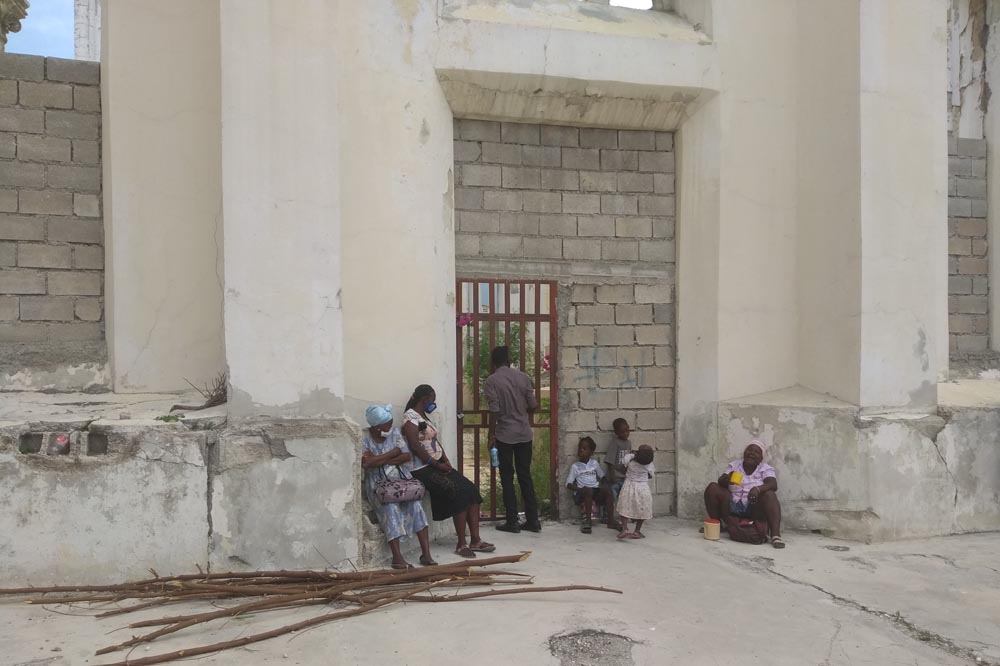
Immediately upon our arrival I became a magnet for the children. Perhaps I was too cynical, but experience has taught me that their parents had probably dispatched the squad of adorable little urchins, who seemed to range in age from about 5 to about 10 years old, to entice me to give them a few centimes. I dearly wanted to oblige, but I knew that it that would only spark a feeding frenzy, and for the moment they seemed content to fight over who got to hold my hand as we toured the grounds.
We met a well-dressed couple distributing literature, and the man was insistent that I listen to his take on the state of religion in Haiti. My French was good enough to catch the basic drift of what he was conveying. He seemed especially intent on disabusing me of the notion that Haitians are cannibals. He brought it up several times. I confess, I hadn’t heard this tall tale, and I told him as much, but he continued to press the point. After I politely listened to his impromptu sermon for a respectable-enough amount of time, he allowed me, along with my entourage consisting of Azda, Vlad and a dozen or so laughing and arguing children, to go on our way.
Leaving the cathedral and the children behind, our overburdened motorcycle wended its way over the potholed streets through throngs of people buying and selling textiles, livestock, kitchenware, and all manner of sundries, individually or from stalls under huge red umbrellas. Eventually we turned into an alley and the distinctive twin red towers of the Marché de Fer hove into view.
My heart skipped a beat. I was overjoyed that Azda had made sure that the Marché de Fer, or Iron Market, was on the itinerary, as it was one of the few tourist attractions that I had read about prior to my arrival, and one which I had hoped would not be closed due to Covid. Back home, the response to the pandemic had turned farmers’ markets, swap meets, and almost all independently owned businesses—basically anything with more cultural impact than a Walmart—into a distant memory, and so I was overjoyed to have the opportunity to visit this living landmark. It lived up to its reputation.
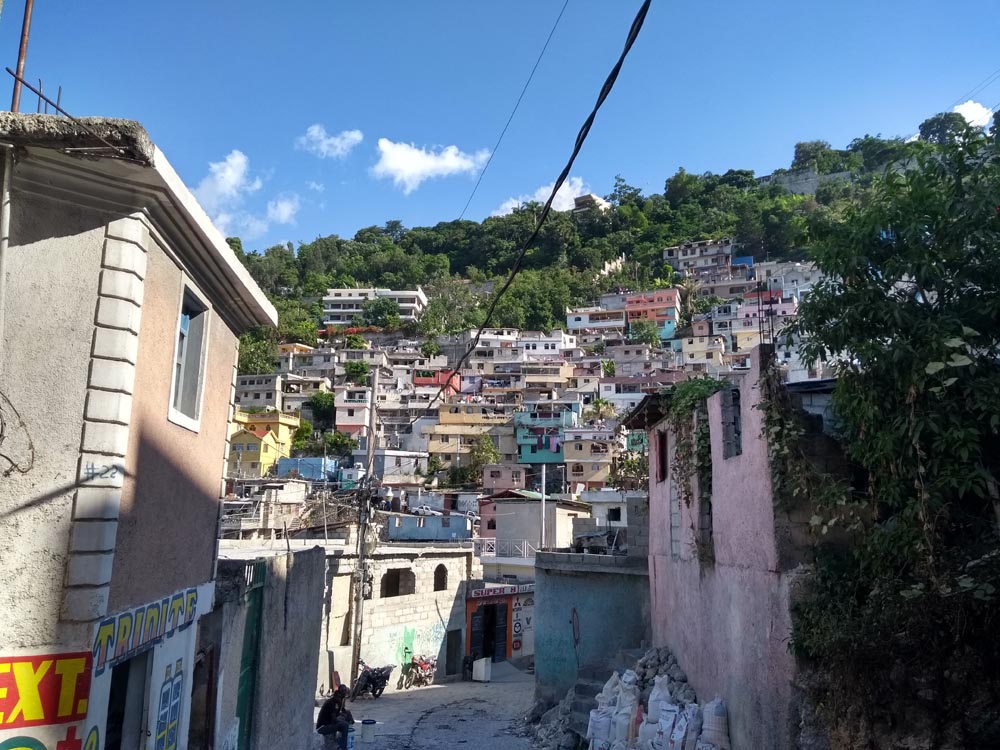
The unique iron structure that houses the market was designed and built in Paris in the 19th century and was intended to serve as the rail station in Cairo, Egypt. The deal fell through, and the then-president of Haiti, Florvil Hyppolite, scooped it up and had it shipped to Port-au-Prince. Since its opening in 1891, the Marché de Fer has served as the main center of commerce in all manner of goods, including (and hence my interest in coming here) art and accoutrements in the Vodou trade.
A friend back in England made me promise to find him a voodoo doll on this visit, and while I was not sure that such things even existed (I always assumed that they were the product of Western sensationalization of Haitian Vodou, and non-existent outside of Hollywood thrillers), I was determined to try. Surely this would be the place.
Sections of the market sell fruits and vegetables, others sell shoes, clothing, and beauty products, but I was brought directly to the section that sold folk art, souvenirs, and cultural items. The standard practice is not to wander about the market alone—as a tourist, this would make it infinitely more difficult to make any headway in your shopping. Rather, we engaged a local guide to show us around, help translate, and quickly find whatever particular items we were seeking. The shopkeepers, who would otherwise be tempted to employ hard-sell tactics on such an obvious foreigner as myself—especially now that Covid had so curtailed tourist traffic—by and large showed deference to the guide’s status, and the fact that he, too, had a job to do. Whereas browsing the dark, narrow aisles of this bustling, chaotic place alone could easily become stressful at best, and dangerous at worst, having a guide made the experience an enjoyable one.
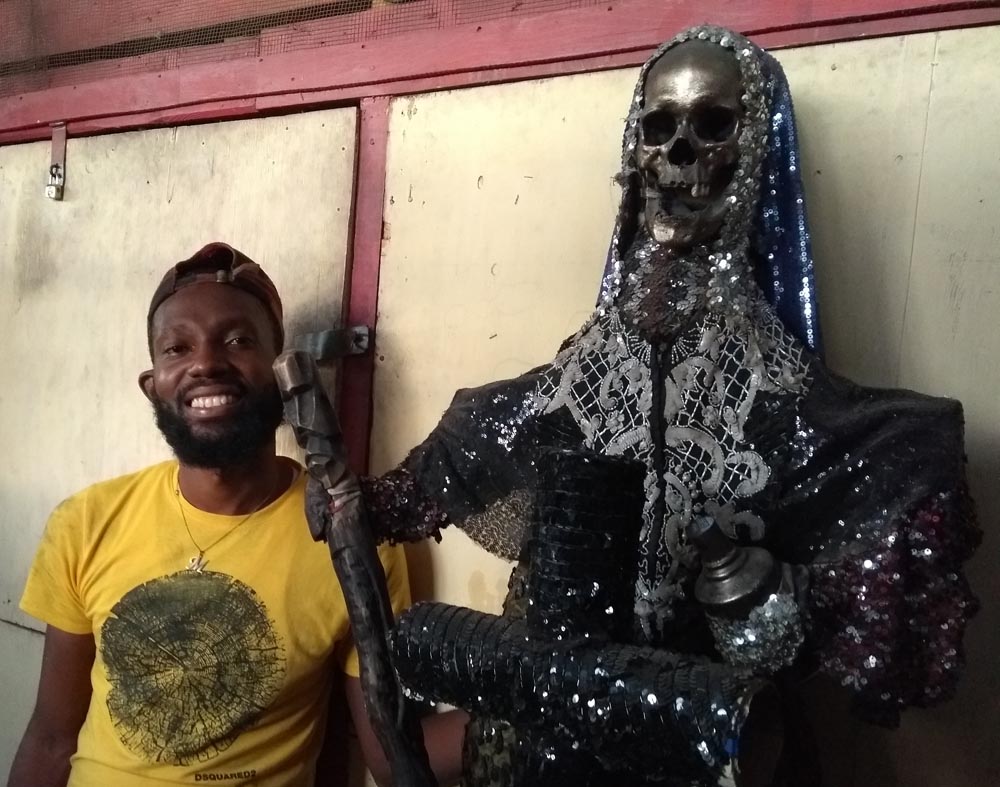
The products on display were beyond belief. The creativity and beauty of the art; paintings, metalwork, carvings in wood and stone, and especially objet trouvé, was phenomenal. The Lwas and saints that populate the Vodou world were clearly the predominant muses, and found expression in inventive combinations of creativity that demonstrated astounding originality and talent.
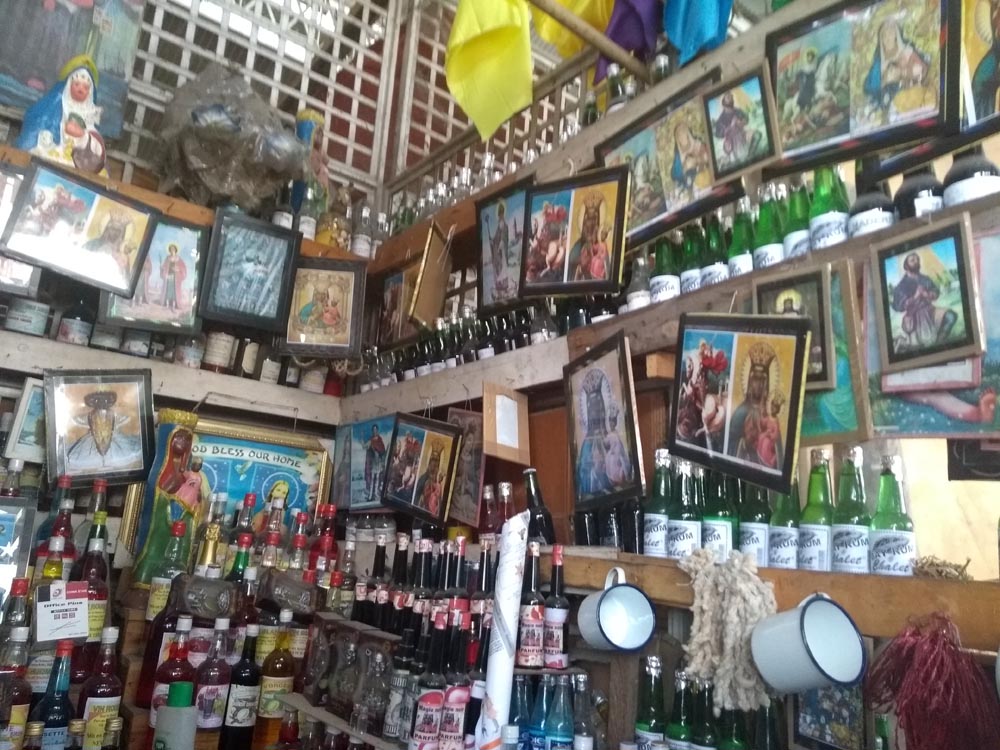
I was especially impressed by the protective objects, most of which were constructed of repurposed dolls, bottles, skulls, and all manner of discarded items. To be sure, there was a ghoulish aspect to many of them, and several stalls dedicated to such macabre fare could, in the aggregate, be almost overwhelming. At one such booth, among the many styles of Vodouified dolls, I spotted a Cabbage Patch Kid nestled in a corner that was identical to the one my sister had when she was seven. My father had driven to another city to buy it for her in 1983, back when the craze for this toy was at a fever pitch. She called him Billy. Only now, Billy had long devil’s horns and a dusty, weathered texture, and was clasping a tiny black coffin.
After getting a feel for the place and browsing what was on offer, it was time to complete my only task for this trip. I asked about voodoo dolls, and to my surprise, the request was easily accommodated. One stallkeeper, a friendly and talented carver who works in stone, reached into a drawer and produced a pair, and through our translator explained to me how they work.
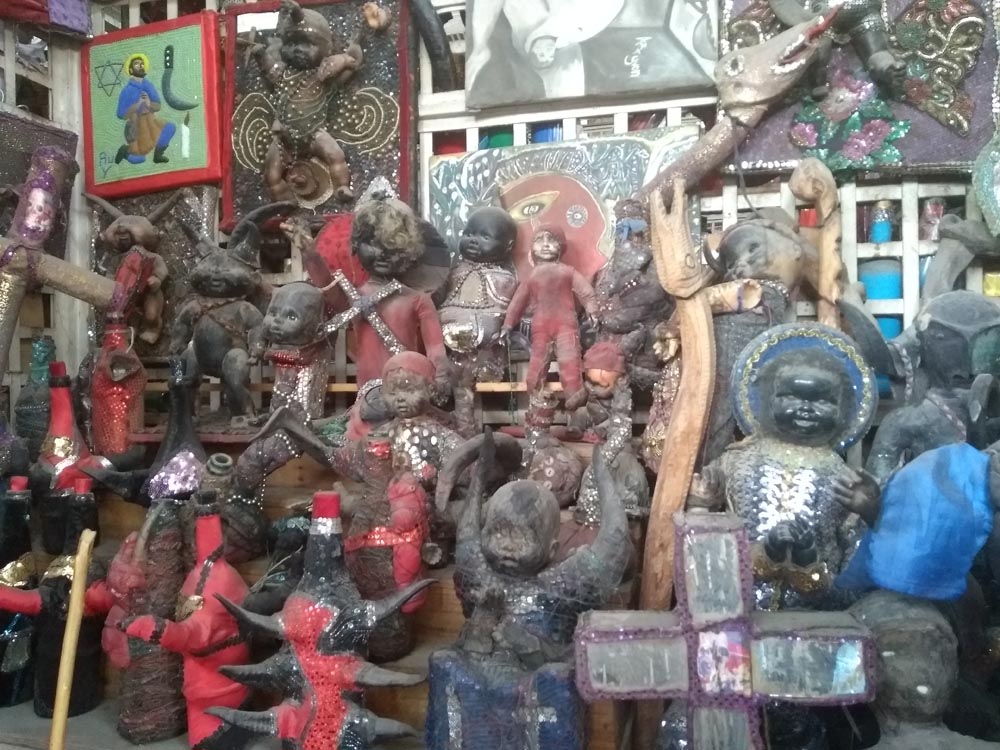
The stuffed cloth dolls are very basic in shape, somewhere between amorphous and humanlike—almost the neckless shape of the Golem of Prague—with tufts of hair sewn in at the top of the head and in the pubic area. They come in two colours, black and red. One doll is an effigy of you, the user. The other represents the object of your affection, be it a lost love or a new romantic interest. Some people try to make the doll look like their target, but this is not necessary: only that some item—a lock of hair, or a nail clipping, or even just a scrap of paper with her name and birthdate—be acquired (don’t get caught!) and attached to the doll. You then position the dolls so that they reflect the intimacy that you are seeking, and bind them together with a length of string. For the spell to work, and to entreat the Lwas to use their powers to remove the obstacles to your love, you must enter a trance state and recite a spell describing the purpose of your magic.
In addition to the voodoo dolls, I was also intent on picking up a souvenir Drapo Vodou, provided I could get one for a reasonable price. This art form, unique to Haiti, involved intricately sequined flags, most often depicting scenes and characters related to the Vodou pantheon. Each one takes the artist weeks to complete, meticulously placing the sequins one by one until the final, shimmering scene is assembled. More than just an art object, flags are essential components used in Vodou rituals. They are worn by dancers, and waved about to attract the Lwas and entice them to take possession of the houngan or mambo. Three or four artists had flags on hand, and were more than happy to show me through their inventory. I settled on one, depicting the veve of Baron Samedi, and took photos of others in case I wanted to return.
I would return twice more to the Marché de Fer during this trip, once after closing, when we were given a private tour through the deserted market by a friendly and knowledgeable guide named Muller Providence. Muller is also an artist whose exceptional work consists of large statues of saints and Lwas, made with objets trouvé, including bottles, skulls, and dolls.
My budding appreciation for Haitian art only grew at our next stop, an artists’ collective called Atis Rezistans, or “artist resistance” in Creole. It is a gallery, workshop, school and museum all in one, and we were lucky enough to meet the driving force behind this effort, artist André Eugène.
When we arrived, André and his mates were in a courtyard watching a football game on the TV. Azda warned me that we would have to pay a small fee if I wanted to take pictures, and as I had left all my money behind at the Iron Market, I chose to leave the camera out of it. André graciously showed us around the many rooms of the complex, filled to overflowing with works of art, and described the work that they do here, both in terms of art and education. His own creations have been exhibited in galleries all over the world, and it is easy to see why.
The pieces on display were every bit as creatively macabre as those at the Marché de Fer, but taken to the next level. Towering figures composed mostly of spare parts—body parts from cars, and body parts from people—stood as sentinels, eerily eying visitors to their habitat. They served also as a memento mori: a reminder that death stands always behind each of us, breathing down our necks, ready to claim us at any moment—something we would do well to be more mindful of in cultures like mine. The sheer number of skulls prompted me to ask André where he sourced his raw materials, but he evaded the question. Skillfully. Children’s dolls were another common resource, looking out with dead eyes as their human form was repurposed to achieve a new mission: one less comforting and playful, and more to challenge and inspire.
Azda wanted to show me the cemetery, but it was getting late, and so I asked him and Vlad to drop me off at the Oloffson. I still had yet to unpack. I also wanted to shower and change into a decent shirt before attending tonight’s Vodou ceremony—what does one wear to such an event? We arranged to meet back there at eight.
